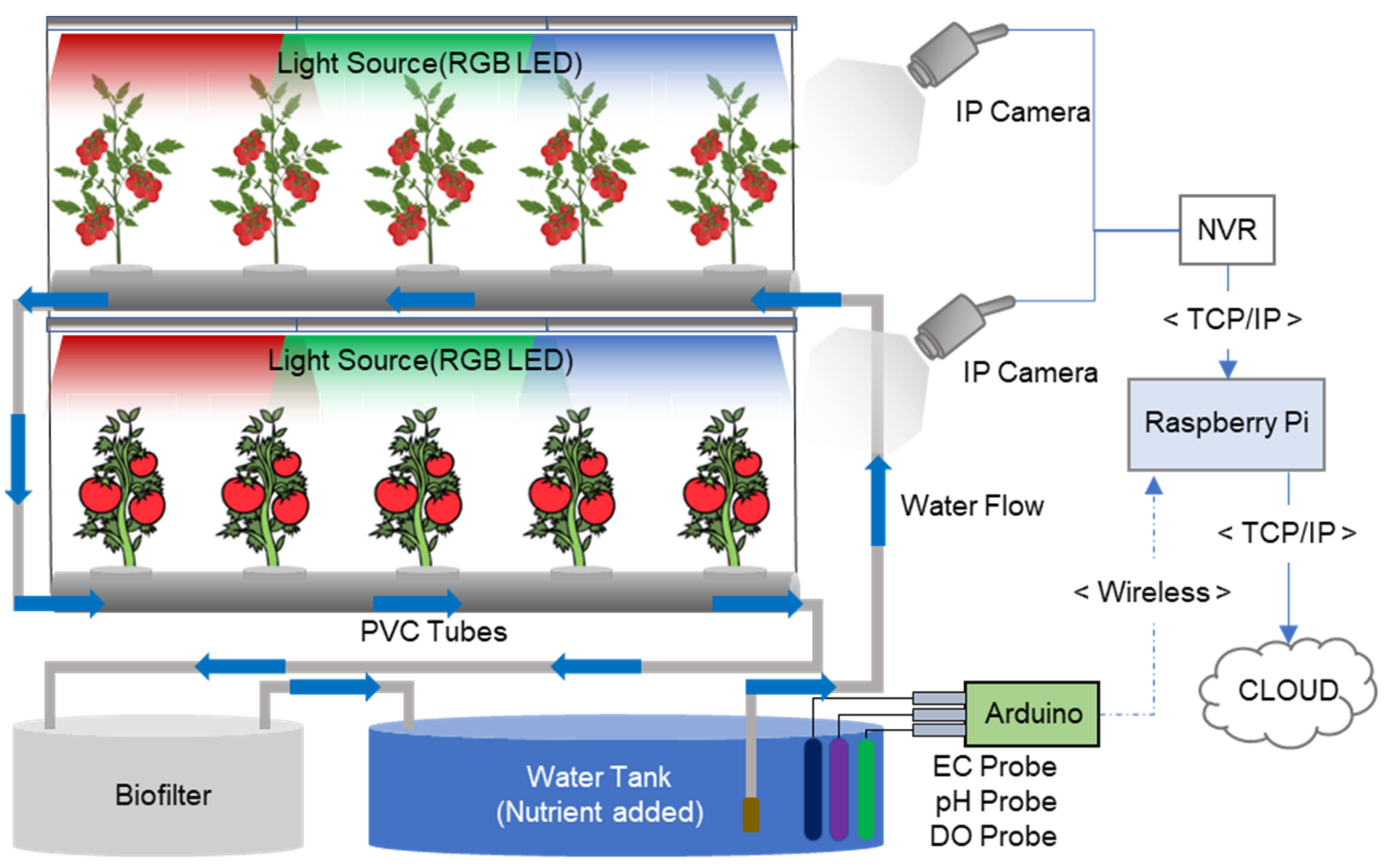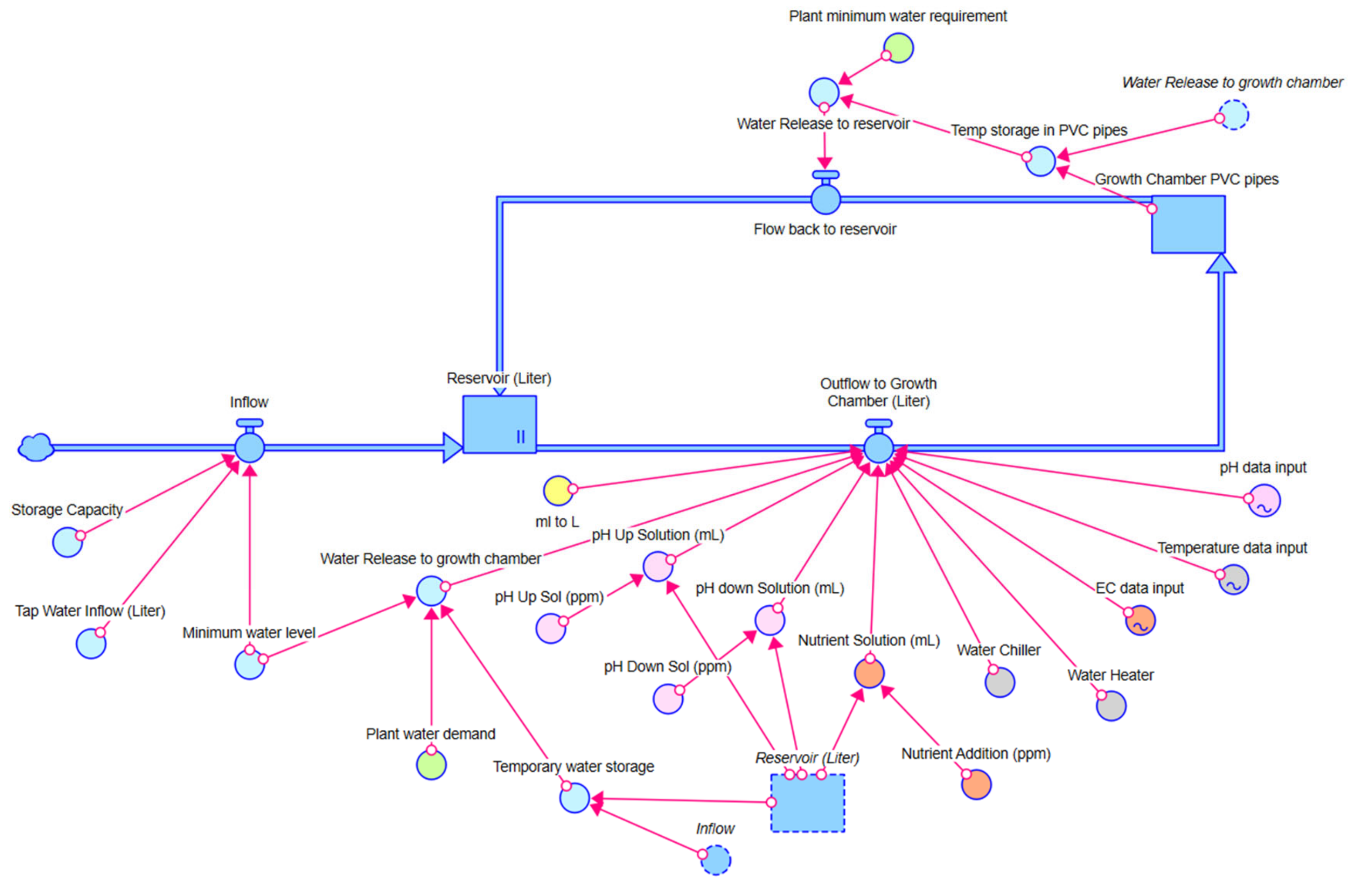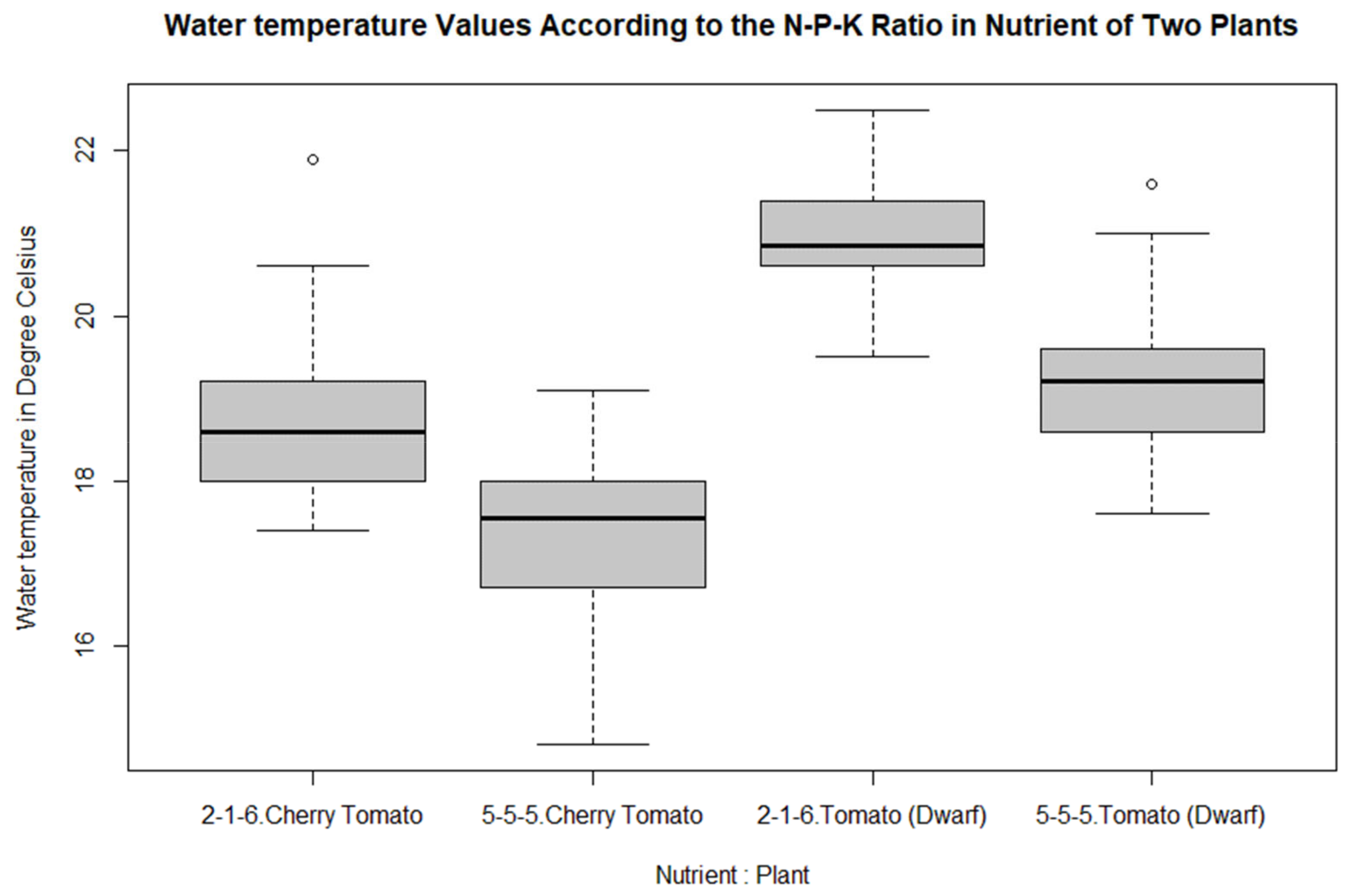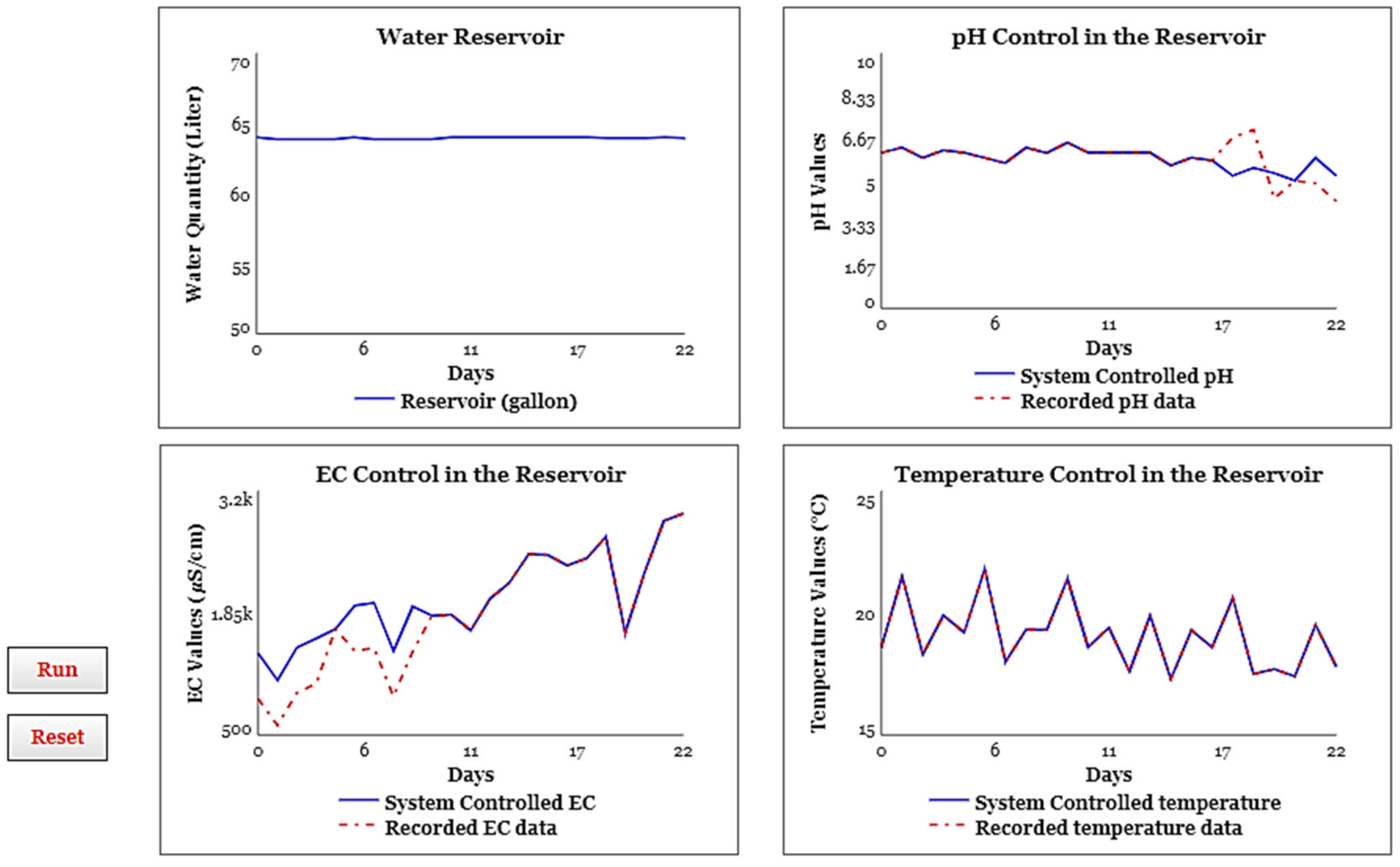An Application of System Dynamics to Characterize Crop Production for Autonomous Indoor Farming Platforms (AIFP)
Abstract
:1. Introduction
2. Materials and Methods
2.1. System Setup
2.2. System with Environmental Factors
2.3. Data Analysis
2.4. System with Nutrient Inputs
2.5. System Dynamics Approach
3. Results
3.1. Impact of Nutrient Solution on the pH Values of the Plants
3.2. Impact of Nutrient Solution on the EC Values of the Plants
3.3. Impact of Nutrient Solution on the Water Temperature Values of the Plants
3.4. System Dynamics and Data Visualization
4. Discussion
5. Conclusions and Future Work
Author Contributions
Funding
Data Availability Statement
Conflicts of Interest
References
- Azunre, G.A.; Amponsah, O.; Peprah, C.; Takyi, S.A.; Braimah, I. A review of the role of urban agriculture in the sustainable city discourse. Cities 2019, 93, 104–119. [Google Scholar] [CrossRef]
- Hodgson, K.; Campbell, M.C.; Bailkey, M. Urban Agriculture: Growing Healthy, Sustainable Places; American Planning Association: Chicago, IL, USA, 2011. [Google Scholar]
- Lin, B.B.; Philpott, S.M.; Jha, S. The future of urban agriculture and biodiversity-ecosystem services: Challenges and next steps. Basic Appl. Ecol. 2015, 16, 189–201. [Google Scholar] [CrossRef]
- Langemeyer, J.; Madrid-Lopez, C.; Beltran, A.M.; Mendez, G.V. Urban agriculture—A necessary pathway towards urban resilience and global sustainability? Landsc. Urban Plan. 2021, 210, 104055. [Google Scholar] [CrossRef]
- McDougall, R.; Kristiansen, P.; Rader, R. Small-scale urban agriculture results in high yields but requires judicious management of inputs to achieve sustainability. Proc. Natl. Acad. Sci. USA 2019, 116, 129–134. [Google Scholar] [CrossRef]
- Subah, Z.; Bala, S.K.; Ryu, J.H. Assessing Urban Flooding Extent of the Baunia Khal Watershed in Dhaka, Bangladesh. Water 2023, 15, 1183. [Google Scholar] [CrossRef]
- Nations, U. World Urbanization Prospects: The 2014 Revision, Highlights. Department of Economic and Social Affairs; Population Division, United Nations: New York, NY, USA, 2014; Volume 32. [Google Scholar]
- Steel, C. Chapter 2 Sitopia–harnessing the power of food. In Sustainable Food Planning: Evolving Theory and Practice; Wageningen Academic Publishers: Cambridge, MA, USA, 2012; p. 188. [Google Scholar]
- Thomaier, S.; Specht, K.; Henckel, D.; Dierich, A.; Siebert, R.; Freisinger, U.B.; Sawicka, M. Farming in and on urban buildings: Present practice and specific novelties of Zero-Acreage Farming (ZFarming). Renew. Agric. Food Syst. 2015, 30, 43–54. [Google Scholar] [CrossRef]
- Kissinger, G.; Herold, M.; De Sy, V. Drivers of Deforestation and Forest Degradation: A Synthesis Report for REDD+ Policymakers; Lexeme Consulting: Vancouver, BC, Canada, 2012. [Google Scholar]
- Change, C. Intergovernmental Panel on Climate Change; World Meteorological Organization: Geneva, Switzerland, 2007; Volume 52. [Google Scholar]
- Subah, Z.; Rashid, M.; Rashid, H. Impacts of Salinity Intrusion on Nitrogen Fixing Microbial Community of Sesbania bispinosa from Three Different Regions of Bangladesh. In Proceedings of the 5th International Conference on Natural Sciences and Technology (ICNST’18), Chittagong, Bangladesh, 30–31 March 2018; pp. 30–31. [Google Scholar]
- Joyce, A.; Goddek, S.; Kotzen, B.; Wuertz, S. Aquaponics: Closing the cycle on limited water, land and nutrient resources. Aquaponics Food Prod. Syst. 2019, 19, 19–34. [Google Scholar]
- Peterson, H.H.; Taylor, M.R.; Baudouin, Q. Preferences of locavores favoring community supported agriculture in the United States and France. Ecol. Econ. 2015, 119, 64–73. [Google Scholar] [CrossRef]
- Opitz, I.; Berges, R.; Piorr, A.; Krikser, T. Contributing to food security in urban areas: Differences between urban agriculture and peri-urban agriculture in the Global North. Agric. Hum. Values 2016, 33, 341–358. [Google Scholar] [CrossRef]
- Benke, K.; Tomkins, B. Future food-production systems: Vertical farming and controlled-environment agriculture. Sustain. Sci. Pract. Policy 2017, 13, 13–26. [Google Scholar] [CrossRef]
- Gómez, C.; Currey, C.J.; Dickson, R.W.; Kim, H.-J.; Hernández, R.; Sabeh, N.C.; Raudales, R.E.; Brumfield, R.G.; Laury-Shaw, A.; Wilke, A.K. Controlled environment food production for urban agriculture. HortScience 2019, 54, 1448–1458. [Google Scholar] [CrossRef]
- Astee, L.Y.; Kishnani, N.T. Building integrated agriculture: Utilising rooftops for sustainable food crop cultivation in Singapore. J. Green Build. 2010, 5, 105–113. [Google Scholar] [CrossRef]
- Weber, C.L.; Matthews, H.S. Food-Miles and the Relative Climate Impacts of Food Choices in the United States; ACS Publications: Washington, DC, USA, 2008. [Google Scholar]
- Orozco, L.; Rico-Romero, L.; Escartin, E.F. Microbiological profile of greenhouses in a farm producing hydroponic tomatoes. J. Food Prot. 2008, 71, 60–65. [Google Scholar] [CrossRef]
- Rogers, M.A. Organic vegetable crop production in controlled environments using soilless media. HortTechnology 2017, 27, 166–170. [Google Scholar] [CrossRef]
- Schnitzler, W. Urban hydroponics for green and clean cities and for food security. In Proceedings of the International Symposium on Soilless Cultivation 1004, Shanghai, China, 22–25 May 2012; pp. 13–26. [Google Scholar]
- Asao, T. Hydroponics: A Standard Methodology for Plant Biological Researches; BoD–Books on Demand: Norderstedt, Germany, 2012. [Google Scholar]
- Jansen, G.; Cila, N.; Kanis, M.; Slaats, Y. Attitudes towards vertical farming at home: A user study. In Proceedings of the 2016 CHI Conference Extended Abstracts on Human Factors in Computing Systems, San Jose, CA, USA, 7–12 May 2016; pp. 3091–3098. [Google Scholar]
- Eaves, J.; Eaves, S. Comparing the Profitability of a Greenhouse to a Vertical Farm in Quebec. Can. J. Agric. Econ. Rev. Can. D’agroeconomie 2018, 66, 43–54. [Google Scholar] [CrossRef]
- Research, G.V. Vertical Farming Market Analysis By Structure, By Component (Hardware, Software, Services), By Growing Mechanism (Aeroponics, Hydroponics), By Crop Category (Fruits Vegetables, & Herbs, Flowers & Ornamentals) And Segment Forecasts, 2023–2030; GVR-1-68038-797-1; Grand View Research: San Francisco, CA, USA, 2022; p. 120. [Google Scholar]
- Resh, H.M. Hydroponic Food Production: A Definitive Guidebook for the Advanced Home Gardener and the Commercial Hydroponic Grower; CRC Press: Boca Raton, FL, USA, 2022. [Google Scholar]
- Baskins, S.; Bond, J.; Minor, T. Unpacking the Growth in Per Capita Availability of Fresh Market Tomatoes; USDA: Washington, DC, USA, 2019. [Google Scholar]
- Maureira, F.; Rajagopalan, K.; Stöckle, C.O. Evaluating tomato production in open-field and high-tech greenhouse systems. J. Clean. Prod. 2022, 337, 130459. [Google Scholar] [CrossRef]
- Watabe, T.; Nakano, Y.; Ahn, D.-H. The Effect of Electrical Conductivity on Fruit Growth Pattern in Hydroponically Grown Tomatoes. Crops 2022, 2, 323–335. [Google Scholar] [CrossRef]
- Lu, T.; Yu, H.; Wang, T.; Zhang, T.; Shi, C.; Jiang, W. Influence of the electrical conductivity of the nutrient solution in different phenological stages on the growth and yield of cherry tomato. Horticulturae 2022, 8, 378. [Google Scholar] [CrossRef]
- Elijah, O.; Rahman, T.A.; Orikumhi, I.; Leow, C.Y.; Hindia, M.N. An overview of Internet of Things (IoT) and data analytics in agriculture: Benefits and challenges. IEEE Internet Things J. 2018, 5, 3758–3773. [Google Scholar] [CrossRef]
- Mehra, M.; Saxena, S.; Sankaranarayanan, S.; Tom, R.J.; Veeramanikandan, M. IoT based hydroponics system using Deep Neural Networks. Comput. Electron. Agric. 2018, 155, 473–486. [Google Scholar] [CrossRef]
- Halgamuge, M.N.; Bojovschi, A.; Fisher, P.M.; Le, T.C.; Adeloju, S.; Murphy, S. Internet of Things and autonomous control for vertical cultivation walls towards smart food growing: A review. Urban For. Urban Green. 2021, 61, 127094. [Google Scholar] [CrossRef]
- Fenitha, J.R.; Mirudhula, S.; Subhashini, K.; Sriharidha, R. Hydroponic Nutrient Solution for Optimized Greenhouse with IOT. In Proceedings of the 2022 International Conference on Advanced Computing Technologies and Applications (ICACTA), Coimbatore, India, 4–5 March 2022; pp. 1–5. [Google Scholar]
- Bhargava, Y.V.; Chittoor, P.K.; Bharatiraja, C. IoT Powered Smart Hydroponic System for Autonomous Irrigation and Crop Monitoring. ECS Trans. 2022, 107, 11937. [Google Scholar] [CrossRef]
- Moreno, M.C.; Suarez, O.J.; Garcia, A.P. IoT-based Automated Greenhouse for Deep Water Culture Hydroponic System. In Proceedings of the 2021 2nd Sustainable Cities Latin America Conference (SCLA), Virtual, 25–27 August 2021; pp. 1–6. [Google Scholar]
- Shamshiri, R.; Kalantari, F.; Ting, K.; Thorp, K.R.; Hameed, I.A.; Weltzien, C.; Ahmad, D.; Shad, Z.M. Advances In Greenhouse Automation and Controlled Environment Agriculture: A Transition to Plant Factories and Urban Agriculture; UTNU Open: Trondheim, Norway, 2018. [Google Scholar]
- Winz, I.; Brierley, G.; Trowsdale, S. The use of system dynamics simulation in water resources management. Water Resour. Manag. 2009, 23, 1301–1323. [Google Scholar] [CrossRef]
- Ryu, J.H.; Contor, B.; Johnson, G.; Allen, R.; Tracy, J. System Dynamics to Sustainable Water Resources Management in the Eastern Snake Plain Aquifer Under Water Supply Uncertainty 1. JAWRA J. Am. Water Resour. Assoc. 2012, 48, 1204–1220. [Google Scholar] [CrossRef]
- Peck, S. Group model building: Facilitating team learning using system dynamics. J. Oper. Res. Soc. 1998, 49, 766–767. [Google Scholar] [CrossRef]
- Simonovic, S.P.; Fahmy, H. A new modeling approach for water resources policy analysis. Water Resour. Res. 1999, 35, 295–304. [Google Scholar] [CrossRef]
- Mandinach, E.B.; Cline, H.F. Classroom Dynamics: Implementing a Technology-Based Learning Environment; Routledge: London, UK, 2013. [Google Scholar]
- An, W.; Wu, D.; Ci, S.; Luo, H.; Adamchuk, V.; Xu, Z. Agriculture cyber-physical systems. In Cyber-Physical Systems; Elsevier: Amsterdam, The Netherlands, 2017; pp. 399–417. [Google Scholar]
- Shamshiri, R.R.; Hameed, I.A.; Thorp, K.R.; Balasundram, S.K.; Shafian, S.; Fatemieh, M.; Sultan, M.; Mahns, B.; Samiei, S. Greenhouse automation using wireless sensors and IoT instruments integrated with artificial intelligence. In Next-Generation Greenhouses for Food Security; IntechOpen: London, UK, 2021. [Google Scholar]
- Subahi, A.F.; Bouazza, K.E. An intelligent IoT-based system design for controlling and monitoring greenhouse temperature. IEEE Access 2020, 8, 125488–125500. [Google Scholar] [CrossRef]
- Soheli, S.J.; Jahan, N.; Hossain, M.B.; Adhikary, A.; Khan, A.R.; Wahiduzzaman, M. Smart greenhouse monitoring system using internet of things and artificial intelligence. Wirel. Pers. Commun. 2022, 124, 3603–3634. [Google Scholar] [CrossRef]
- Enokela, J.A.; Othoigbe, T.O. An automated greenhouse control system using Arduino prototyping platform. Aust. J. Eng. Res. 2015, 1, 64–73. [Google Scholar]
- Subeesh, A.; Mehta, C. Automation and digitization of agriculture using artificial intelligence and internet of things. Artif. Intell. Agric. 2021, 5, 278–291. [Google Scholar] [CrossRef]
- Gorjian, S.; Ebadi, H.; Trommsdorff, M.; Sharon, H.; Demant, M.; Schindele, S. The advent of modern solar-powered electric agricultural machinery: A solution for sustainable farm operations. J. Clean. Prod. 2021, 292, 126030. [Google Scholar] [CrossRef]
- Zamora-Izquierdo, M.A.; Santa, J.; Martínez, J.A.; Martínez, V.; Skarmeta, A.F. Smart farming IoT platform based on edge and cloud computing. Biosyst. Eng. 2019, 177, 4–17. [Google Scholar] [CrossRef]
- Hirsch, G.B.; Levine, R.; Miller, R.L. Using system dynamics modeling to understand the impact of social change initiatives. Am. J. Community Psychol. 2007, 39, 239–253. [Google Scholar] [CrossRef]
- Balali, H.; Viaggi, D. Applying a system dynamics approach for modeling groundwater dynamics to depletion under different economical and climate change scenarios. Water 2015, 7, 5258–5271. [Google Scholar] [CrossRef]
- Bowles, D.E.; Gardiner, L.R. Supporting process improvements with process mapping and system dynamics. Int. J. Product. Perform. Manag. 2018, 67, 1255–1270. [Google Scholar] [CrossRef]
- Verstraete, W.; Philips, S. Nitrification–denitrification processes and technologies in new contexts. In Nitrogen, the Confer-Ns; Elsevier: Amsterdam, The Netherlands, 1998; pp. 717–726. [Google Scholar]
- Allaire, J. RStudio: Integrated development environment for R; RStudio: Boston, MA, USA, 2012. [Google Scholar]
- Kronthaler, F.; Zöllner, S. Data Analysis with RStudio; Springer: Berlin/Heidelberg, Germany, 2021. [Google Scholar]
- Van der Loo, M.P. Learning RStudio for R Statistical Computing; Packt Publishing Ltd.: Birmingham, UK, 2012. [Google Scholar]
- Verzani, J. Getting Started with RStudio; O’Reilly Media, Inc.: Sebastopol, CA, USA, 2011. [Google Scholar]
- Armstrong, R.A. Recommendations for analysis of repeated-measures designs: Testing and correcting for sphericity and use of manova and mixed model analysis. Ophthalmic Physiol. Opt. 2017, 37, 585–593. [Google Scholar] [CrossRef]
- Friedrich, S.; Konietschke, F.; Pauly, M. Analysis of multivariate data and repeated measures designs with the R package MANOVA. RM. arXiv 2018, arXiv:1801.08002. [Google Scholar]
- Mood, D.P.; Morrow, J.R.; McQueen, M.B. Multivariate ANOVA (MANOVA). In Introduction to Statistics in Human Performance; Routledge: London, UK, 2019; pp. 293–310. [Google Scholar]
- O’Brien, R.G.; Kaiser, M.K. MANOVA method for analyzing repeated measures designs: An extensive primer. Psychol. Bull. 1985, 97, 316. [Google Scholar] [CrossRef] [PubMed]
- Tavares, L.R.; Costa, T.S.; de Melo, K.B.; Silva, J.L.d.S.; Villalva, M.G. Statistical analysis ANOVA and MANOVA of irradiation and temperature database for photovoltaic systems. In Proceedings of the 2020 IEEE International Conference on Industrial Technology (ICIT), Buenos Aires, Argentina, 26–28 August 2020; pp. 554–559. [Google Scholar]
- Weerahandi, S. Generalized Inference in Repeated Measures: Exact Methods in Manova and Mixed Models; John Wiley & Sons: Hoboken, NJ, USA, 2004; Volume 500. [Google Scholar]
- Krzysko, M.; Smiałowski, T.; Wołynski, W. Analysis of multivariate repeated measures data using a manova model and principal components. Biom. Lett. 2014, 51, 103–114. [Google Scholar] [CrossRef]
- Ling, T.-Y.; Chiang, Y.-C. Well-being, health and urban coherence-advancing vertical greening approach toward resilience: A design practice consideration. J. Clean. Prod. 2018, 182, 187–197. [Google Scholar] [CrossRef]
- Cliff, M.A.; Li, J.B.; Toivonen, P.M.; Ehret, D.L. Effects of nutrient solution electrical conductivity on the compositional and sensory characteristics of greenhouse tomato fruit. Postharvest Biol. Technol. 2012, 74, 132–140. [Google Scholar] [CrossRef]
- Martínez-Damian, M.; Rodríguez-Pérez, J.; Cruz-Alvarez, O.; Colinas-León, M. Yield and physicochemical quality in experimental lines of Solanum lycopersicum var. cerasiforme cultivated with different levels of electrical conductivity. Chil. J. Agric. Anim. Sci. Ex Agro-Cienc. 2018, 34, 152–164. [Google Scholar]
- Patil, S.; Kadam, U.; Mane, M.; Mahale, D.; Dhekale, J. Hydroponic growth media (substrate): A review. Int. Res. J. Pure Appl. Chem. 2020, 21, 106–113. [Google Scholar] [CrossRef]
- Suhardiyanto, H.; Arif, C.; Setiawan, B.I. Optimization of EC values of nutrient solution for tomato fruits quality in hydroponics system using artificial neural network and genetic algorithms. ITB J. Sci. 2009, 41, 38–49. [Google Scholar] [CrossRef]
- Sharma, N.; Acharya, S.; Kumar, K.; Singh, N.; Chaurasia, O.P. Hydroponics as an advanced technique for vegetable production: An overview. J. Soil Water Conserv. 2018, 17, 364–371. [Google Scholar] [CrossRef]
- Suhandy, D. The effect of EC levels of nutrient solution on the growth, yield, and quality of tomatoes (Solanum lycopersicum) under the hydroponic system. J. Agric. Eng. Biotechnol. (JAEB) 2014, 2, 7–12. [Google Scholar]
- White, P.J.; Karley, A.J. Potassium. In Cell Biology of Metals and Nutrients; Springer: Berlin/Heidelberg, Germany, 2010; pp. 199–224. [Google Scholar]
- Rengel, Z.; Damon, P.M. Crops and genotypes differ in efficiency of potassium uptake and use. Physiol. Plant. 2008, 133, 624–636. [Google Scholar] [CrossRef] [PubMed]
- Almeida, D.P.; Huber, D.J. Apoplastic pH and inorganic ion levels in tomato fruit: A potential means for regulation of cell wall metabolism during ripening. Physiol. Plant. 1999, 105, 506–512. [Google Scholar] [CrossRef]
- Borgognone, D.; Colla, G.; Rouphael, Y.; Cardarelli, M.; Rea, E.; Schwarz, D. Effect of nitrogen form and nutrient solution pH on growth and mineral composition of self-grafted and grafted tomatoes. Sci. Hortic. 2013, 149, 61–69. [Google Scholar] [CrossRef]
- Rakocy, J.E. Aquaponics—Integrating fish and plant culture. In Aquaculture Production Systems; Wiley-Blackwell: Ames, IA, USA, 2012; pp. 344–386. [Google Scholar]
- Trejo-Téllez, L.I.; Gómez-Merino, F.C. Nutrient solutions for hydroponic systems. In Hydroponics-a Standard Methodology for Plant Biological Researches; InTech: Rijeka, Croatia, 2012; pp. 1–22. [Google Scholar]







| Nutrient Sl No. | N-P-K Ratio | Other Nutrients and Concentrations | Nutrient Amount (mL) in 100 L | Nutrients in 1 L | Frequency of Nutrient Application | Water Addition in System (L) |
|---|---|---|---|---|---|---|
| 1 | 2-1-6 | Mg (0.5%) | 396 | 3.96 | Weekly | 72 |
| 2 | 5-5-5 | Mg (1.5%), S (1%), Ca (5%), B (0.01%), Co (0.0005%), Fe (0.1%), Cu (0.01%), Mn (0.05%), Mo (0.0008%), Zn (0.015%) | 396 | 3.96 | Weekly | 68 |
| Model: pH ~ (1 | Day) + Nutrient + ‘Water Temp’ + EC + Plant | |||
|---|---|---|---|
| Effect | df | F | p.Value |
| Nutrient | 1, 72.88 | 17.85 *** | <0.001 |
| ‘Water Temp’ | 1, 81.24 | 1.52 | 0.222 |
| EC | 1, 76.3 | 30.95 *** | <0.001 |
| Plant | 1, 74.19 | 5.9 * | 0.018 |
| Model: EC ~ (1 | Day) + Nutrient + ‘Water Temp’ + pH + Plant | |||
|---|---|---|---|
| Effect | df | F | p.Value |
| Nutrient | 1, 72.72 | 0.87 | 0.355 |
| ‘Water Temp’ | 1, 81.83 | 0.17 | 0.680 |
| pH | 1, 77.29 | 30.45 *** | <0.001 |
| Plant | 1, 74.07 | 1.87 | 0.176 |
| Model: ‘Water Temp’ ~ (1 | Day) + Nutrient + pH + EC + Plant | |||
|---|---|---|---|
| Effect | df | F | p.Value |
| Nutrient | 1, 70.92 | 18.63 *** | <0.001 |
| pH | 1, 81.52 | 1.43 | 0.234 |
| EC | 1, 81.57 | 0.25 | 0.616 |
| Plant | 1, 69.5 | 66.6 *** | <0.001 |
Disclaimer/Publisher’s Note: The statements, opinions and data contained in all publications are solely those of the individual author(s) and contributor(s) and not of MDPI and/or the editor(s). MDPI and/or the editor(s) disclaim responsibility for any injury to people or property resulting from any ideas, methods, instructions or products referred to in the content. |
© 2023 by the authors. Licensee MDPI, Basel, Switzerland. This article is an open access article distributed under the terms and conditions of the Creative Commons Attribution (CC BY) license (https://creativecommons.org/licenses/by/4.0/).
Share and Cite
Ryu, J.H.; Subah, Z.; Baek, J. An Application of System Dynamics to Characterize Crop Production for Autonomous Indoor Farming Platforms (AIFP). Horticulturae 2023, 9, 1318. https://doi.org/10.3390/horticulturae9121318
Ryu JH, Subah Z, Baek J. An Application of System Dynamics to Characterize Crop Production for Autonomous Indoor Farming Platforms (AIFP). Horticulturae. 2023; 9(12):1318. https://doi.org/10.3390/horticulturae9121318
Chicago/Turabian StyleRyu, Jae Hyeon, Zarin Subah, and Jeonghyun Baek. 2023. "An Application of System Dynamics to Characterize Crop Production for Autonomous Indoor Farming Platforms (AIFP)" Horticulturae 9, no. 12: 1318. https://doi.org/10.3390/horticulturae9121318





